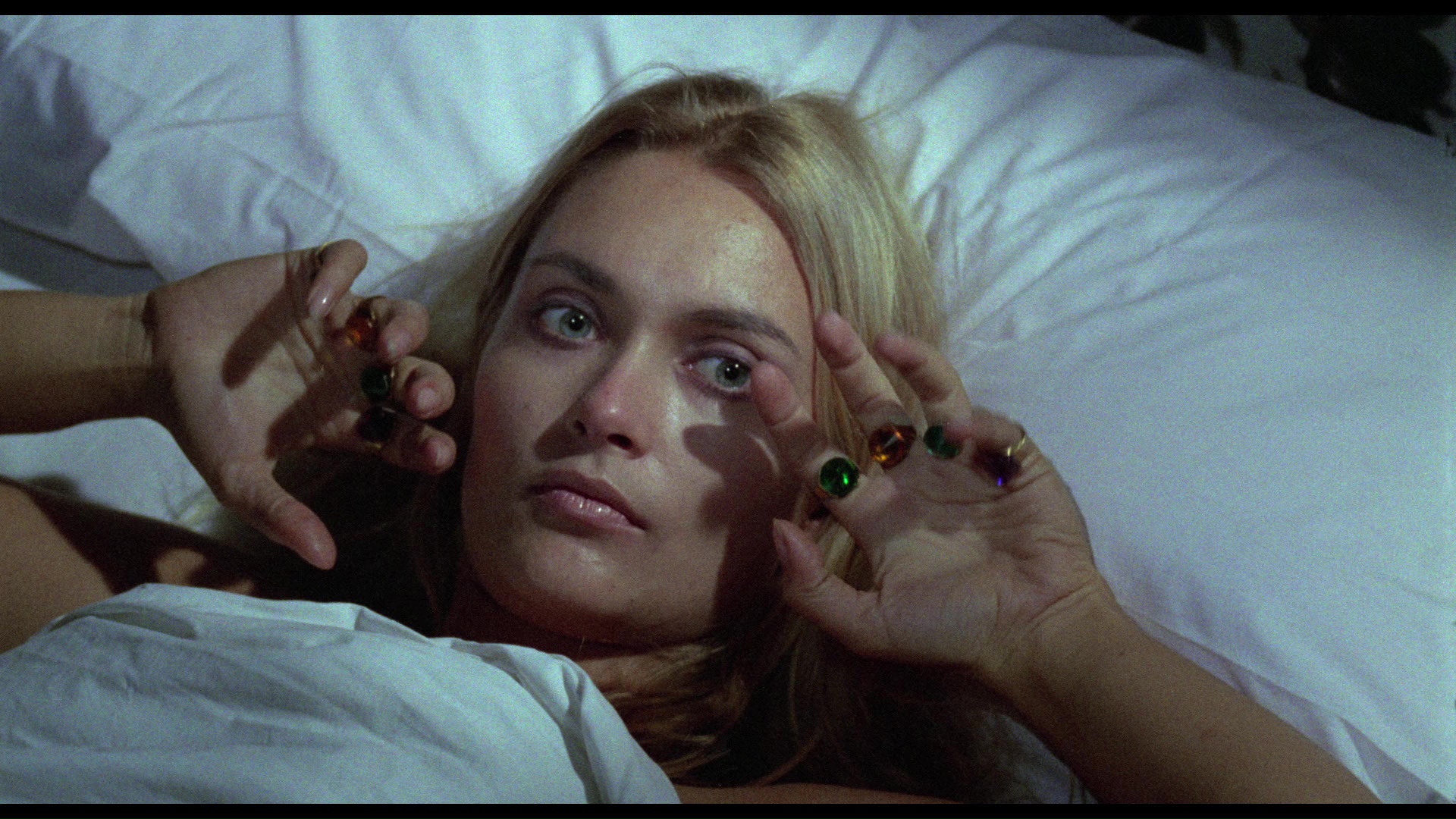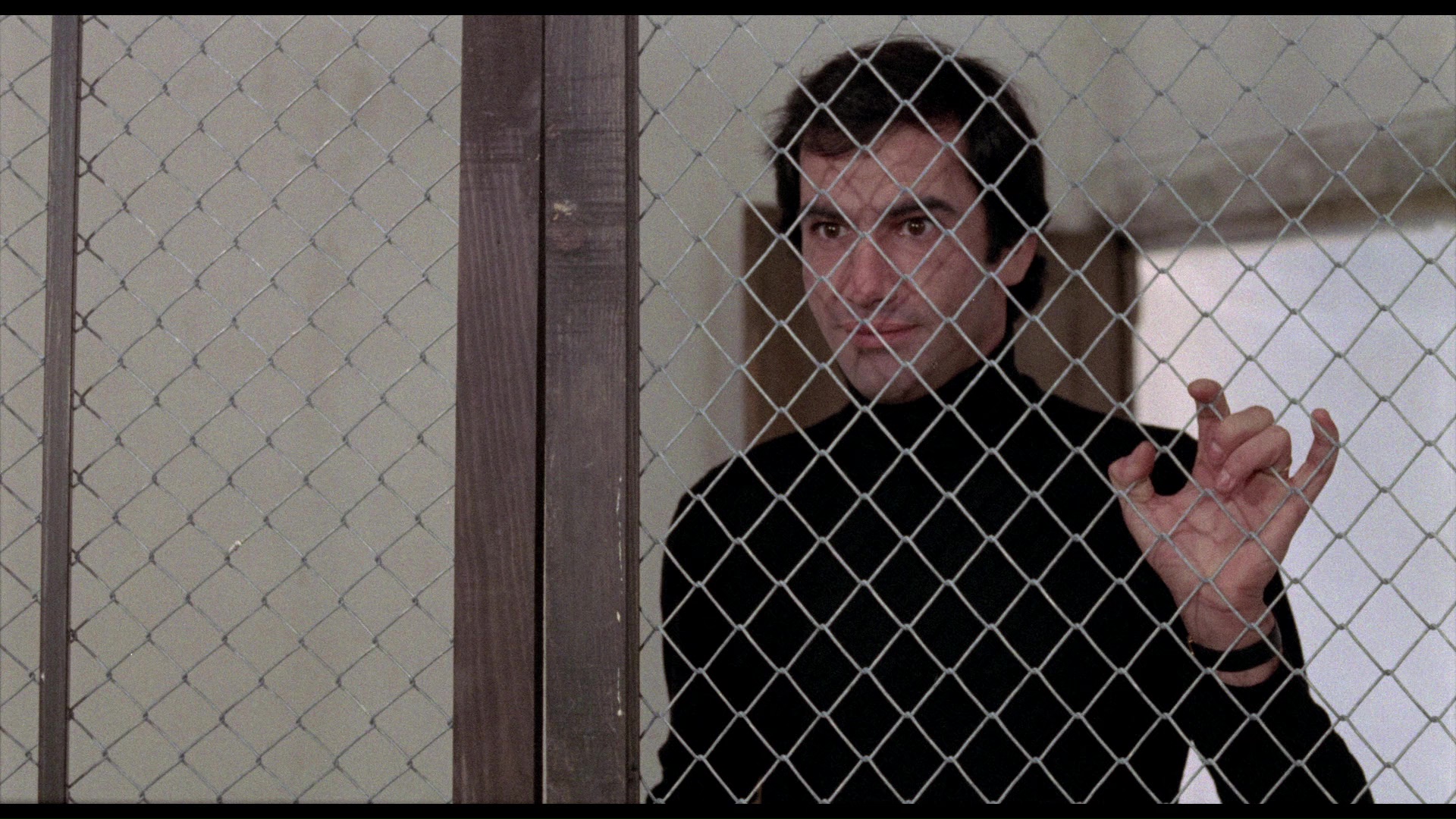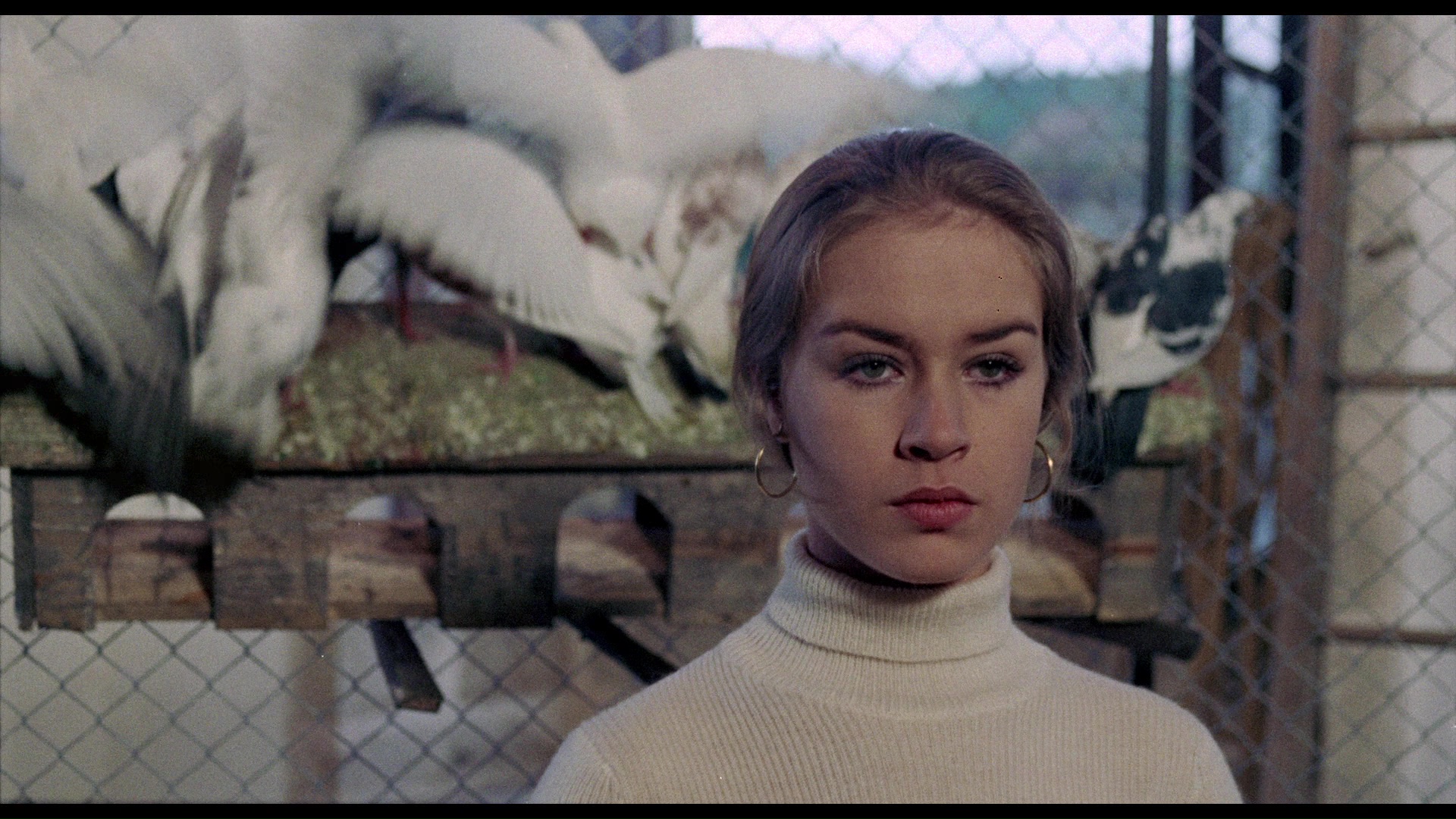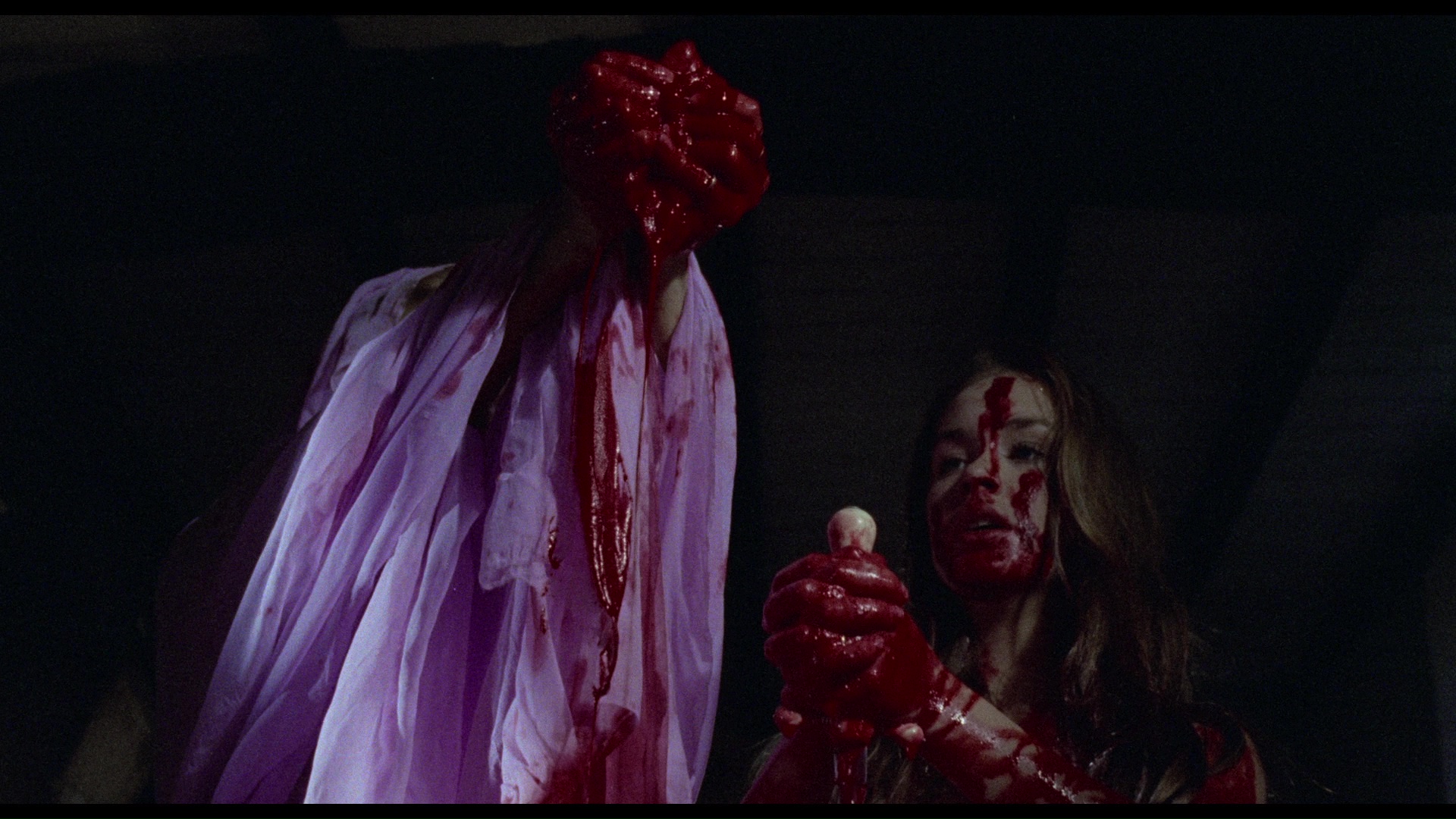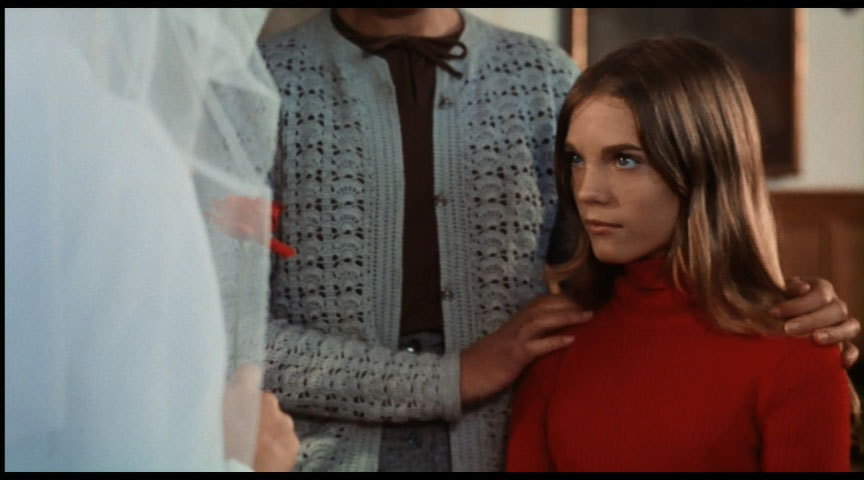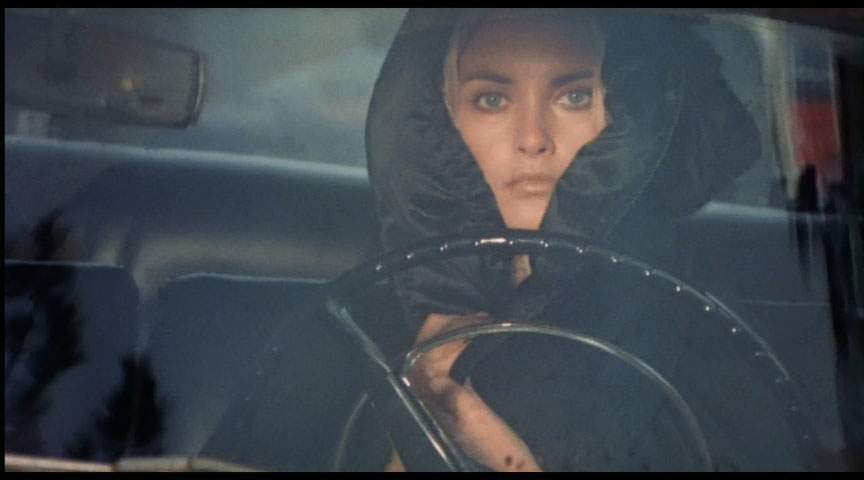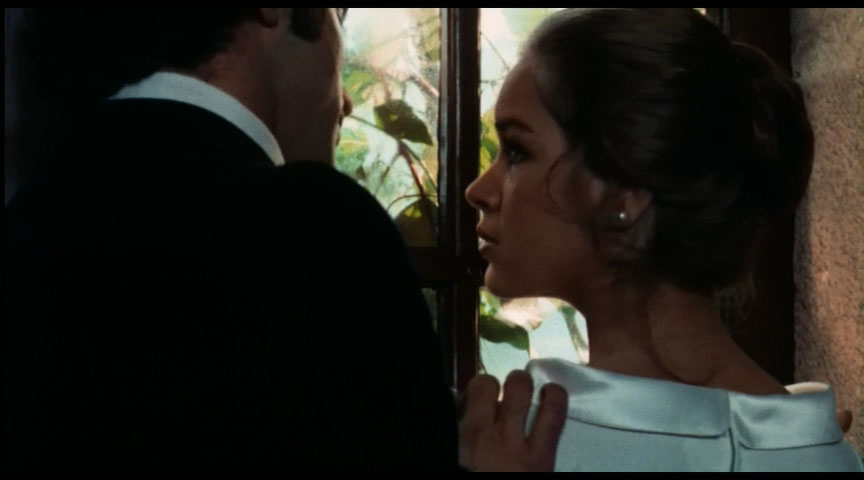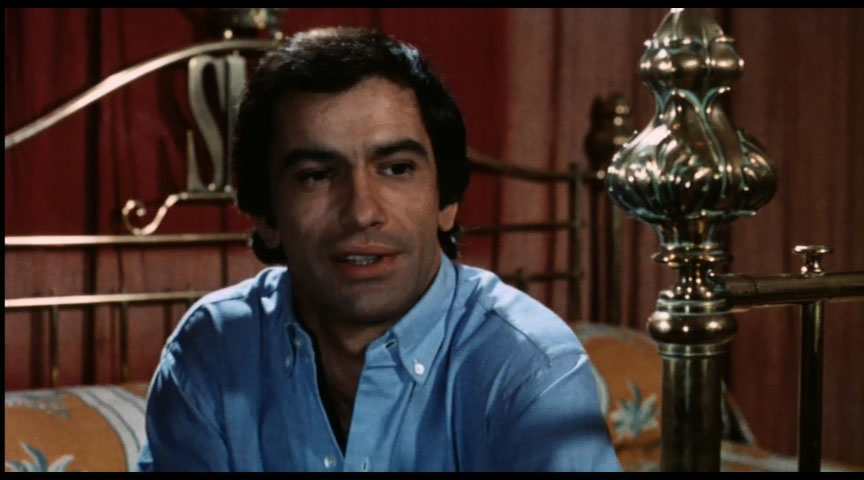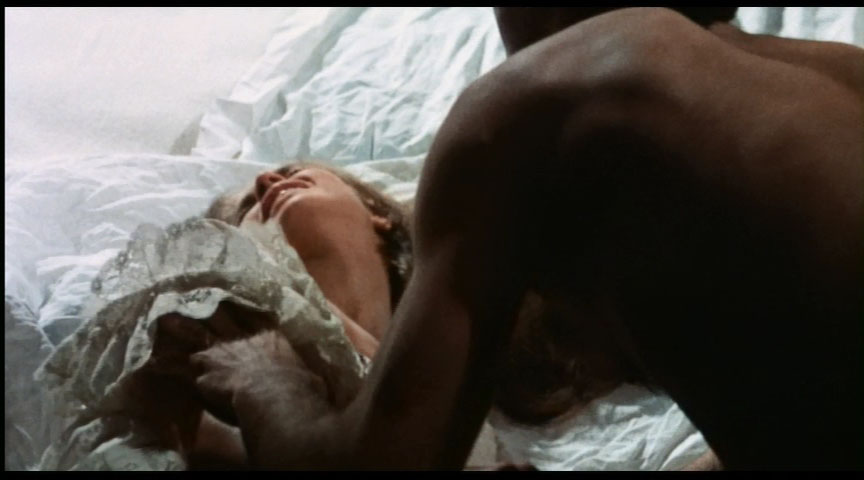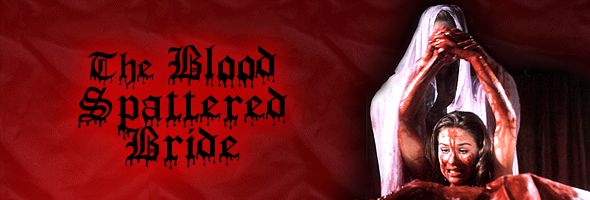
Color, 1972, 102 mins. 7 secs.
Directed by Vicente Aranda
Starring Simón Andreu, Maribel Martín, Alexandra Bastedo
Mondo Macabro (Blu-ray) (US R0 HD), Anchor Bay, Blue Underground (US R1 NTSC), Artus (DVD) (France R2 PAL) / WS (1.85:1) (16:9)
Thanks 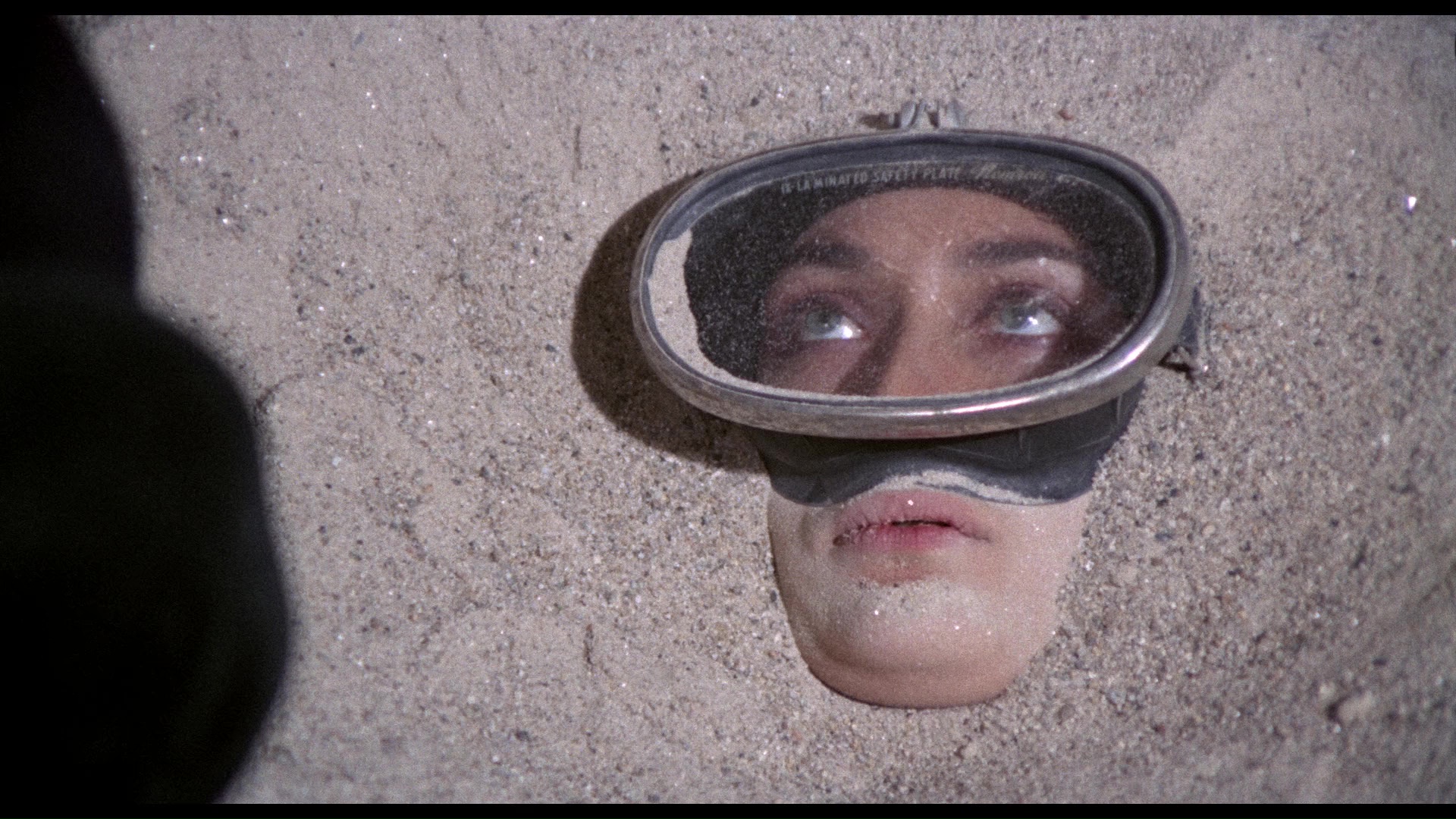 to its title alone, this Spanish
to its title alone, this Spanish 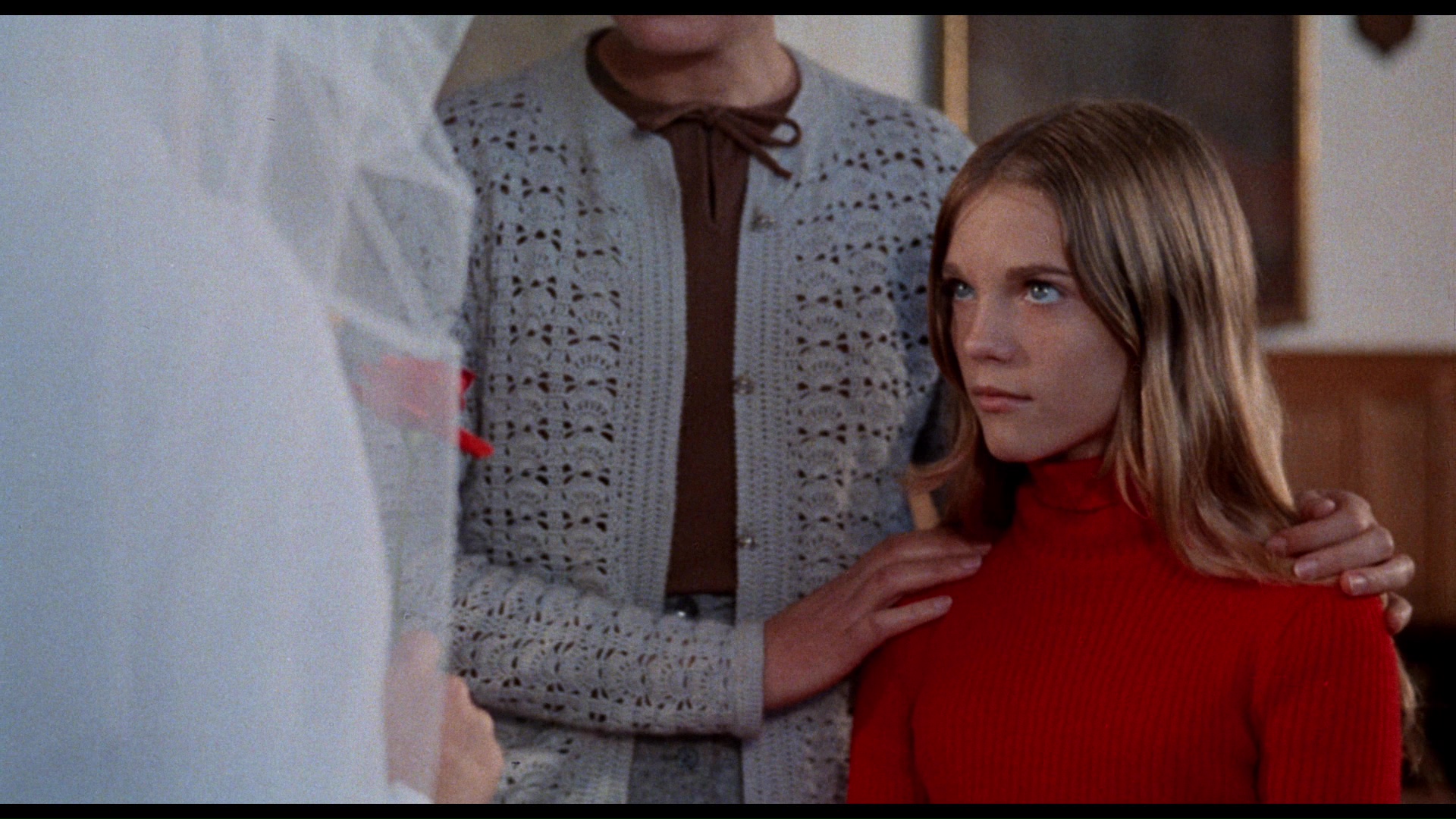 entry in the lesbian vampire craze of the 1970s became a 42nd Street and drive-in favorite. Like most European horror films, it suffered a number of heavy cuts before reaching the States, but its bizarre imagery and visceral nastiness still gripped viewers well into the home video era. Fully restored to its original perverse glory, this film has since been reappraised as a striking and essential entry in development of erotic cinematic horror, and forming a sort of sexy, dreamlike trilogy along with Harry Kümel's Daughters of Darkness and Roger Vadim's Blood and Roses, this nominal adaptation of J. Sheridan Le Fanu's oft-filmed Carmilla strays very far from its source but still captures the twisted essence of the Gothic vampire tale.
entry in the lesbian vampire craze of the 1970s became a 42nd Street and drive-in favorite. Like most European horror films, it suffered a number of heavy cuts before reaching the States, but its bizarre imagery and visceral nastiness still gripped viewers well into the home video era. Fully restored to its original perverse glory, this film has since been reappraised as a striking and essential entry in development of erotic cinematic horror, and forming a sort of sexy, dreamlike trilogy along with Harry Kümel's Daughters of Darkness and Roger Vadim's Blood and Roses, this nominal adaptation of J. Sheridan Le Fanu's oft-filmed Carmilla strays very far from its source but still captures the twisted essence of the Gothic vampire tale.
Unstable young bride Susan (The House That Screamed's Martín) is prone to hallucinating rape attacks while her chauvinist husband (Death Walks at Midnight's Andreu) is out of the hotel room. She insists they change hotels, so the not quite happy couple winds up at an ancestral home vaguely connected to the husband. They discover historical markers relating to the home's original family, the Karsteins, and Susan experiences violent dreams involving a strange woman in white. One day while strolling out on the beach, the husband discovers a naked woman (Stigma's Bastedo) buried in the sand, with only her snorkel providing her air. He digs her out and takes her home, where she reveals herself to be Mircalla Karstein -- who, not so coincidentally, is the same woman from Susan's dreams. Repelled  by her husband's macho demands, Susan falls under Mircalla's spell and embarks on a spree of bloody mayhem.
by her husband's macho demands, Susan falls under Mircalla's spell and embarks on a spree of bloody mayhem.
In 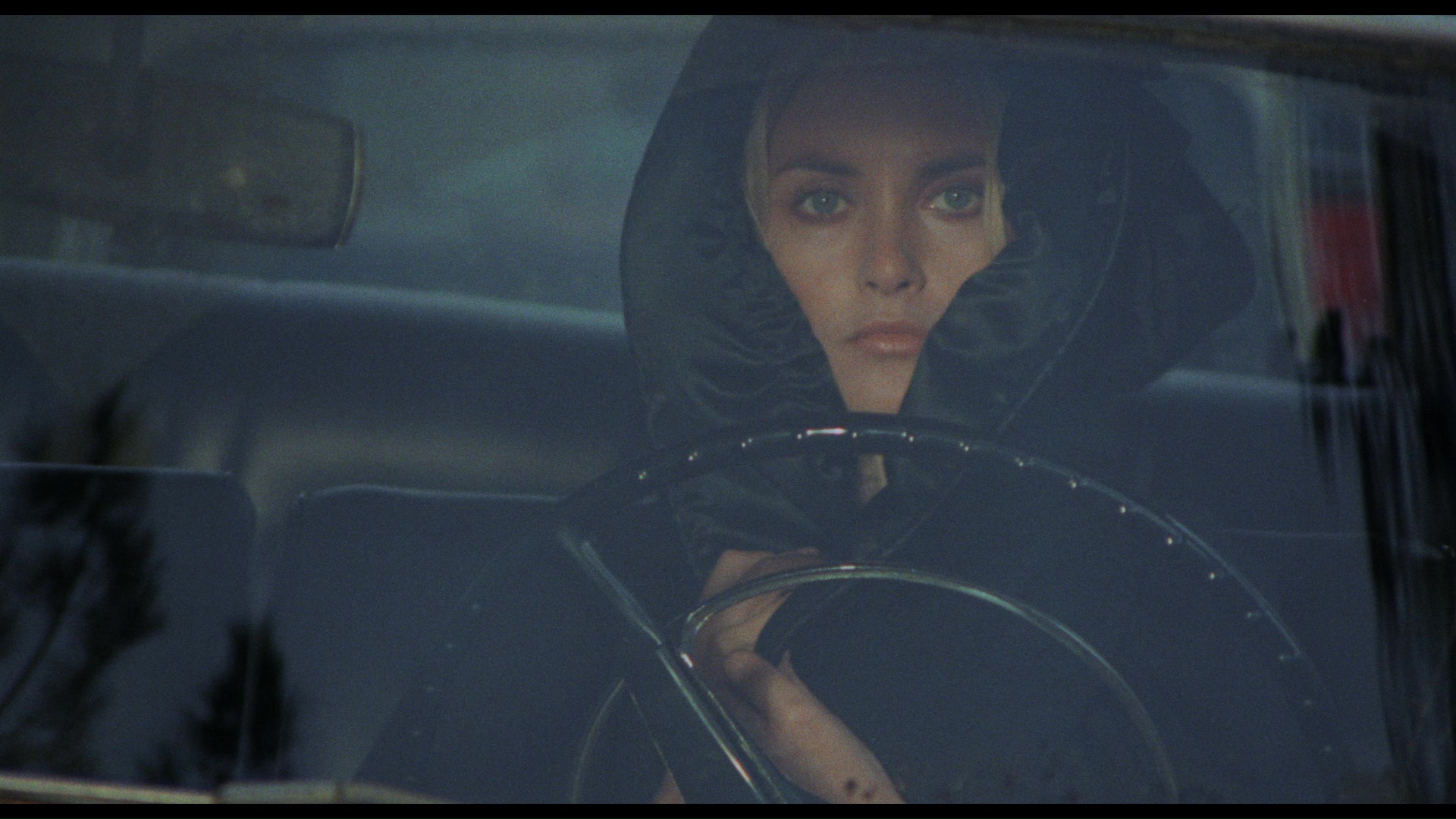 its censored 80 minute form, The Blood Spattered Bride (La novia ensangrentada) is a fascinating but incomplete horrific fantasy laced with unexpected surrealism and nudity. The much longer European version significantly reinstates a number of graphic sequences, including a jolting amount of frontal nudity and genital-related violence, but it also greatly improves the pacing of the film. Mircalla's memorable discovery on the beach, arguably the highlight of the film, doesn't occur now until an hour into the film, and the character of Carol (Rosa Rodriguez), has been greatly expanded and now plays a vital role in the story's development. Rumors abounded about various versions of the film, with prints altered to emphasize either the nudity or the gore, and the infamous heart-cutting finale has been the subject of much speculation over the years. The film itself will not appeal to all tastes, thanks to the slow pacing and disorienting storyline, but game viewers will be rewarded with a unique vampire tale graced with hefty dollops of eroticism. The strange, jittery music score creates unease from the opening scene, and the evocative imagery of director Aranda (who later became a rakish art-house auteur with wild films like La pasión turca, El amante bilingüe, and the torrid Victoria Abril vehicle, Lovers) wouldn't look out of place in one of Jean Rollin's vampire
its censored 80 minute form, The Blood Spattered Bride (La novia ensangrentada) is a fascinating but incomplete horrific fantasy laced with unexpected surrealism and nudity. The much longer European version significantly reinstates a number of graphic sequences, including a jolting amount of frontal nudity and genital-related violence, but it also greatly improves the pacing of the film. Mircalla's memorable discovery on the beach, arguably the highlight of the film, doesn't occur now until an hour into the film, and the character of Carol (Rosa Rodriguez), has been greatly expanded and now plays a vital role in the story's development. Rumors abounded about various versions of the film, with prints altered to emphasize either the nudity or the gore, and the infamous heart-cutting finale has been the subject of much speculation over the years. The film itself will not appeal to all tastes, thanks to the slow pacing and disorienting storyline, but game viewers will be rewarded with a unique vampire tale graced with hefty dollops of eroticism. The strange, jittery music score creates unease from the opening scene, and the evocative imagery of director Aranda (who later became a rakish art-house auteur with wild films like La pasión turca, El amante bilingüe, and the torrid Victoria Abril vehicle, Lovers) wouldn't look out of place in one of Jean Rollin's vampire 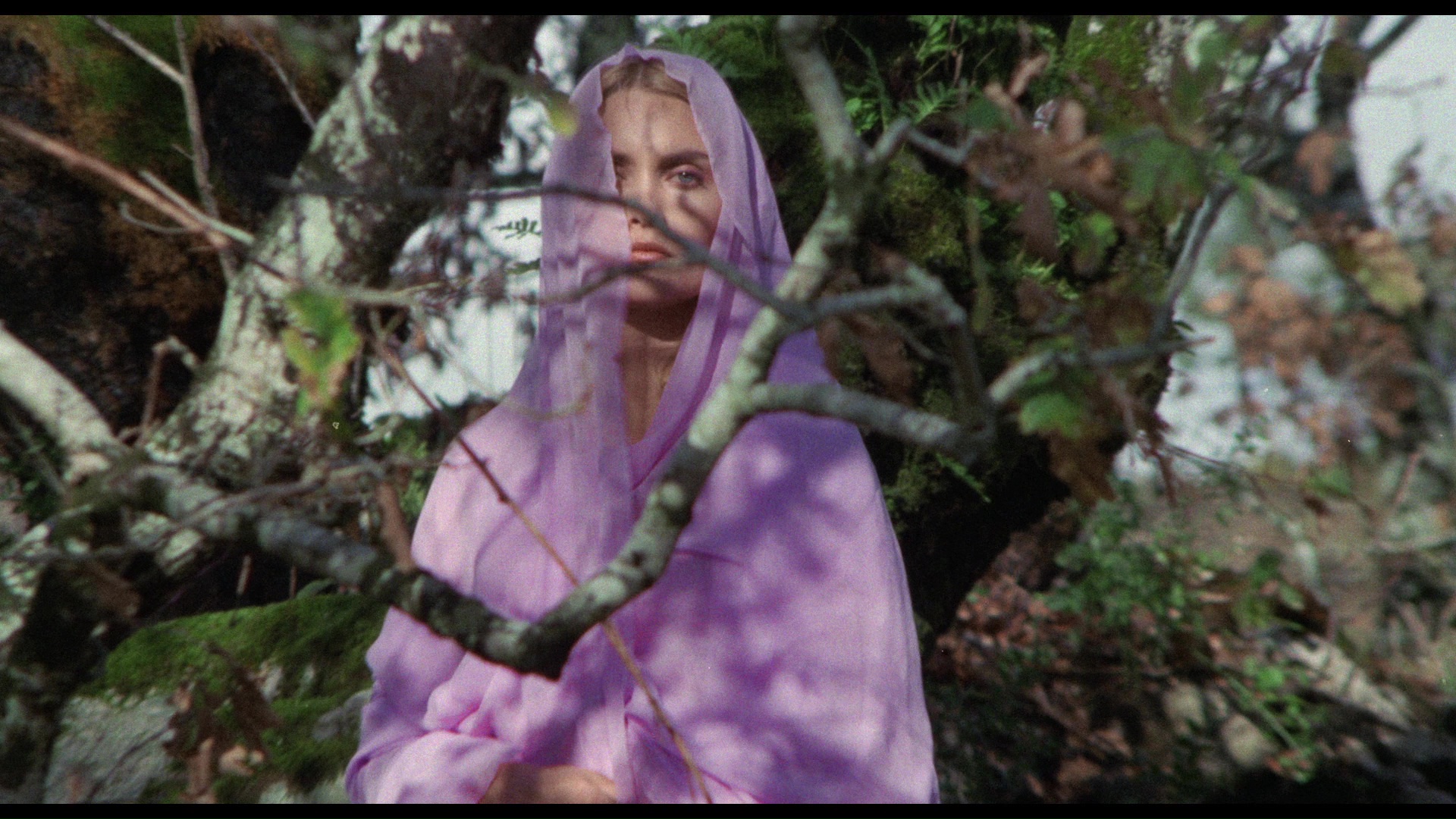 sagas. Strangely, some critics (including Phil Hardy's landmark Overlook Film Encyclopedia: Horror) have taken the film to task as some sort of misogynist macho fantasy, something that's tough to reconcile with the film's clearly repulsed treatment of its male lead and the rest of Aranda's movie output. On the other hand, animal lovers should be warned that there's a sickening scene of brutality involving a fox that may have been passable at the time but feels wholly unnecessary now.
sagas. Strangely, some critics (including Phil Hardy's landmark Overlook Film Encyclopedia: Horror) have taken the film to task as some sort of misogynist macho fantasy, something that's tough to reconcile with the film's clearly repulsed treatment of its male lead and the rest of Aranda's movie output. On the other hand, animal lovers should be warned that there's a sickening scene of brutality involving a fox that may have been passable at the time but feels wholly unnecessary now.
Anchor  Bay's 2000 DVD of The Blood Spattered Bride was a much-needed upgrade at the time and looked vastly superior to the muddy, full frame tapes released by companies like MPI over the years. However, the added clarity also emphasizes the film's age, and like many '70s Spanish films, the shadows have a tendency to become brown and muddy in darker scenes. Also included is the wacko US combo trailer with I Dismember Mama, which has been amazing home video collectors since its inclusion on Mad Ron's Prevues from Hell many years ago. (Note that the film's title is also shown on the marquee as The Blood Splattered Bride.) The same disc was reissued in 2006 by Blue Underground.
Bay's 2000 DVD of The Blood Spattered Bride was a much-needed upgrade at the time and looked vastly superior to the muddy, full frame tapes released by companies like MPI over the years. However, the added clarity also emphasizes the film's age, and like many '70s Spanish films, the shadows have a tendency to become brown and muddy in darker scenes. Also included is the wacko US combo trailer with I Dismember Mama, which has been amazing home video collectors since its inclusion on Mad Ron's Prevues from Hell many years ago. (Note that the film's title is also shown on the marquee as The Blood Splattered Bride.) The same disc was reissued in 2006 by Blue Underground.
In 2017, Mondo Macabro gave the film an essential upgrade to Blu-ray with a much-needed special edition sold as a red case limited edition directly via the company's site, limited to 1,000 units. The new 4K restoration from the original negative is a real eye popper with gorgeously detailed film grain and textures, with even minor elements like our heroine's corduroy jacket getting a much more tactile feel here. Playback options include the crystal clear English and Spanish versions with LPCM mono audio, with optional English 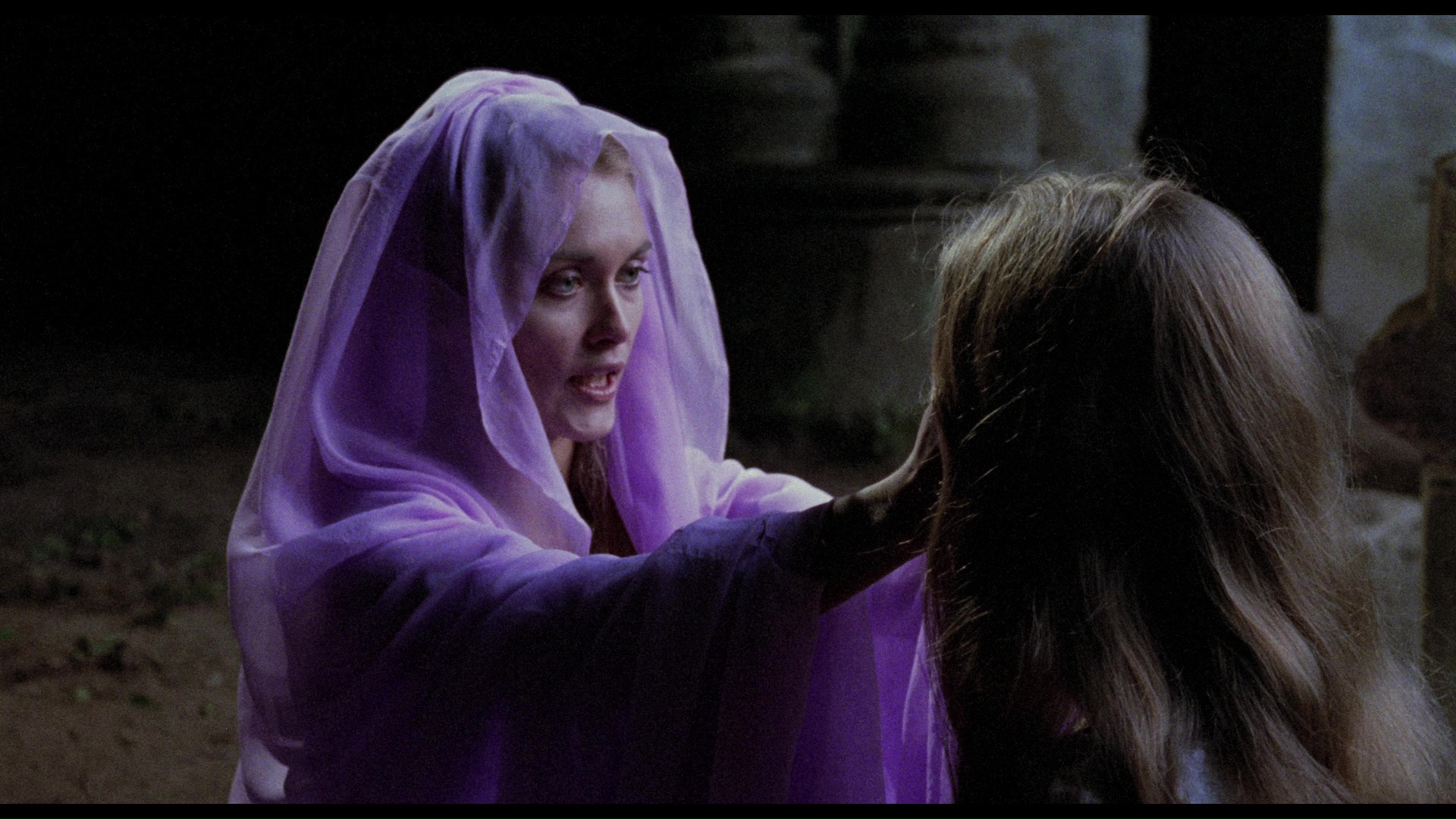 subtitles for the Spanish track and the credit sequences / opening quote in their respective languages (including closing credits omitted on past releases). Both versions were looped later by other voice actors, but the film was obviously shot in English with the lip movements only matching that dialogue. (Oddly, the Spanish track briefly switches over to French a handful of times, presumably to spackle in moments that were cut out domestically.)
subtitles for the Spanish track and the credit sequences / opening quote in their respective languages (including closing credits omitted on past releases). Both versions were looped later by other voice actors, but the film was obviously shot in English with the lip movements only matching that dialogue. (Oddly, the Spanish track briefly switches over to French a handful of times, presumably to spackle in moments that were cut out domestically.) 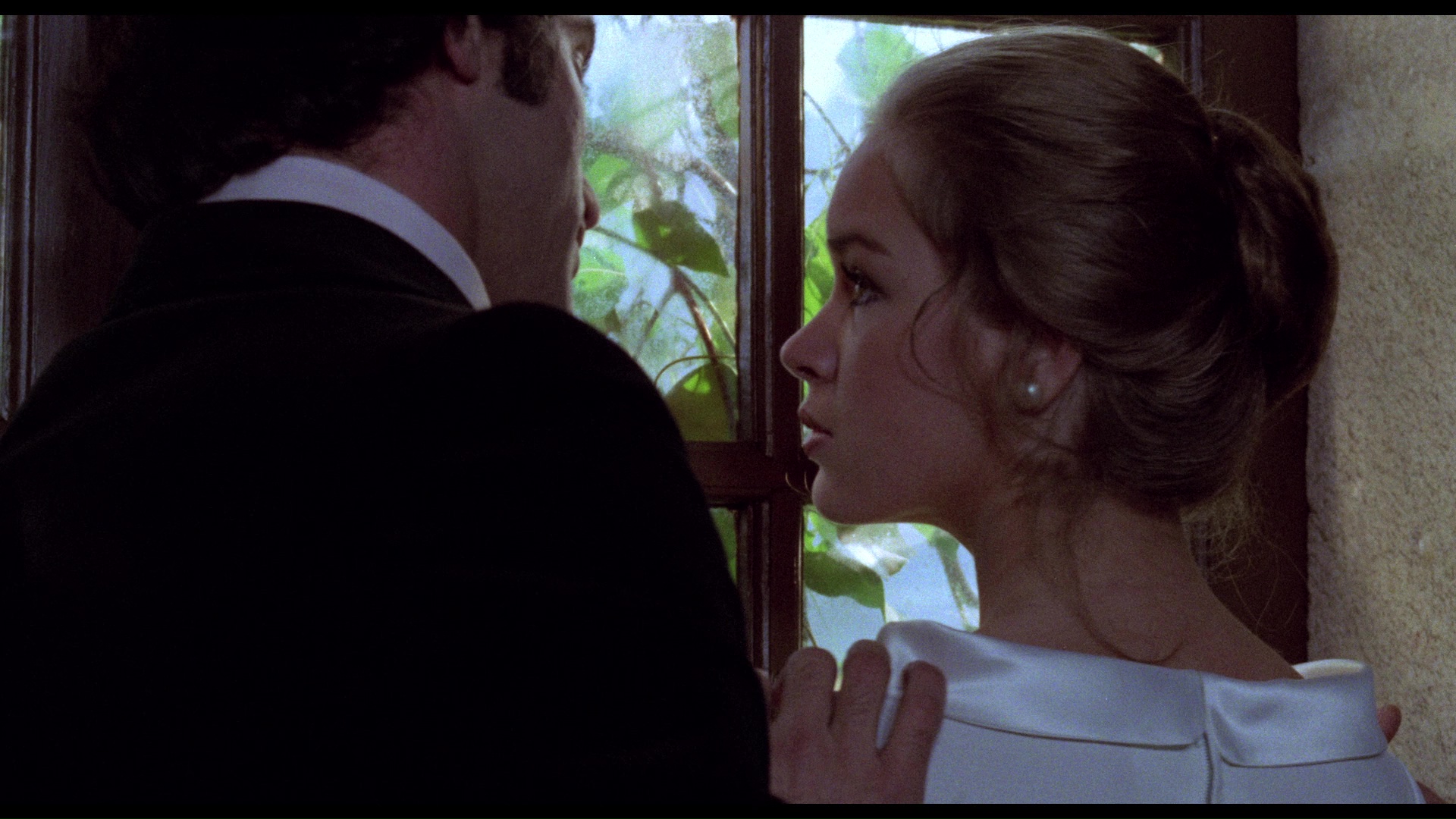
A very solid, well-versed new audio commentary with Daughters of Darkness' Kat Ellinger and Samm Deighan puts the film in context within the cycle of lesbian vampire films, discusses Aranda's reputation in his native country, explains the background of Spain necessary to appreciated the film, the female archetypes at play in the story, the queasy gender conflicts at play here including the innocent child treatment of Susan, and the ties to other filmmakers of the era like Eloy de la Iglesia, Jess Franco, José Ramón Larraz, and Pedro Almodóvar. Andreu is featured in a substantial two-part interview by Uwe Huber segregated into a discussion of this film (32m13s) and then the rest of his career (28m36s), including some sifting through lobby cards and video releases of his films as he chats (mostly in excellent English) about how he got into the business and had to do some impromptu translating and dialogue coaching on this film, not to mention a completely bizarre tangent about actor (and government agent) Dean Selmier, his affection for this particular film as one of his dozen favorites, his discomfort with the level of sexual explicitness Aranda wanted, the advantages of speaking English (not with a precisely Castilian accent), his work with "crazy" Amando de Ossorio and Luciano Ercoli, and lots more. Next up, cinematographer Fernando Arribas appears for a featurette 32m26s) about his switch from studying to become an engineer to working in cinematography, his first collaboration with Aranda on Fata Morgana, the working relationship with Bastedo and Andreu, the shooting locations, and the trickery involved in shooting the memorable beach scene. Finally, author Jonathan 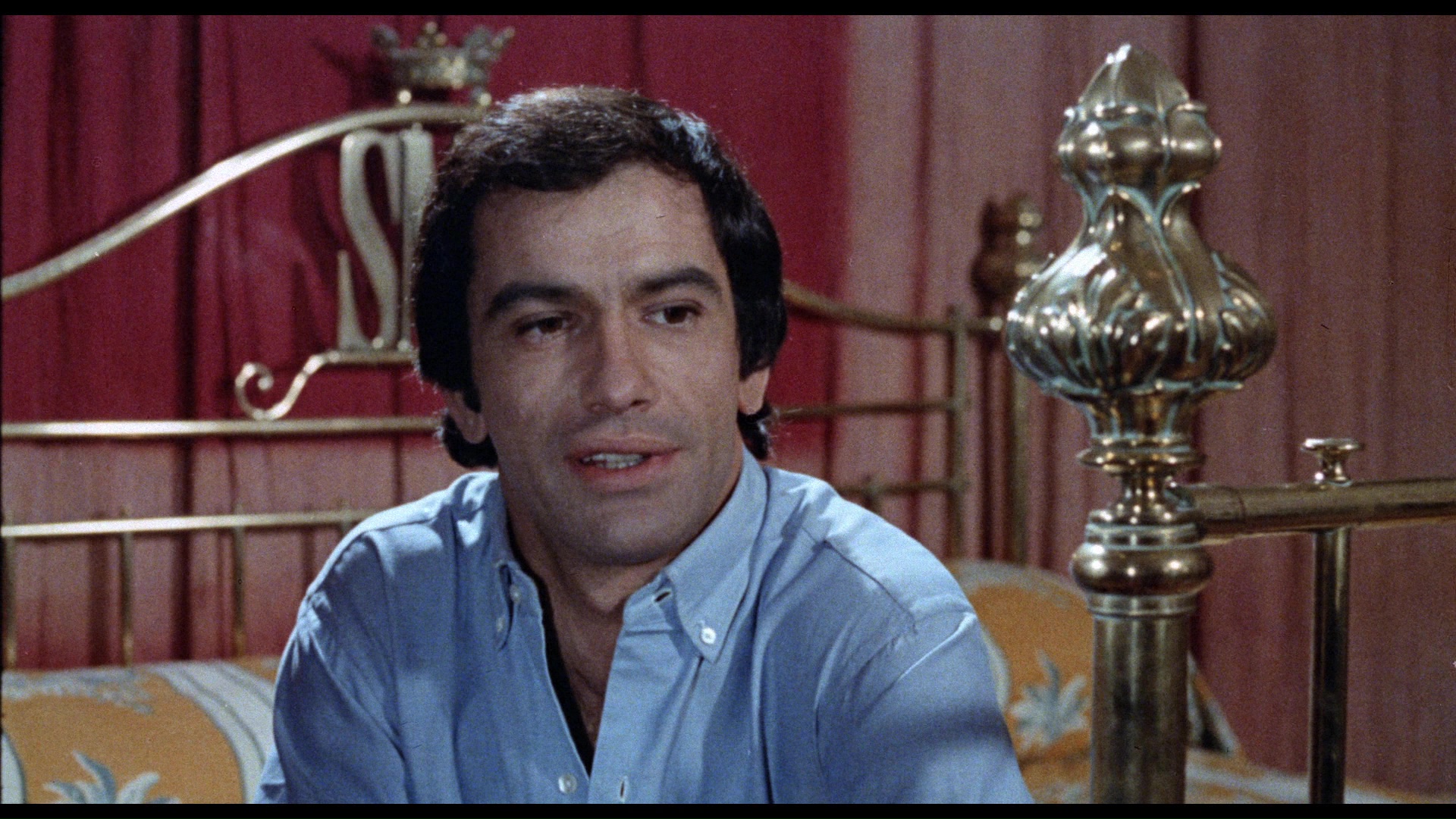 Rigby (Euro Gothic: Classics of Continental Horror Cinema) offers his own dissection (28m20s) of this place in the European classic horror pantheon as it plays
Rigby (Euro Gothic: Classics of Continental Horror Cinema) offers his own dissection (28m20s) of this place in the European classic horror pantheon as it plays 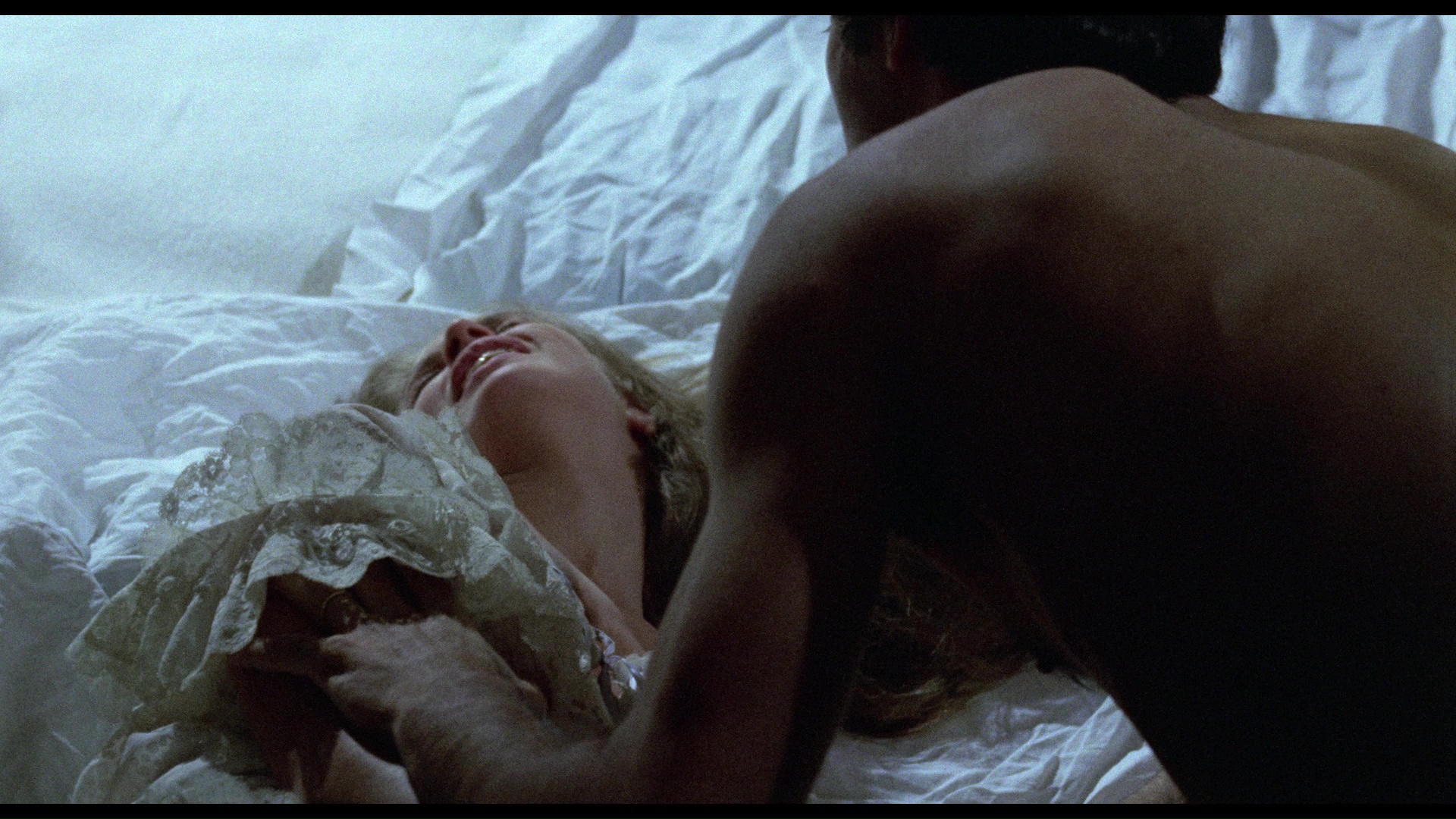 with familiar horror tropes (a mangled portrait, a mysterious chapel, etc.) in an unorthodox and extremely Spanish fashion compared to other Carmilla-inspired Euro horrors like The Vampire Lovers and Terror in the Crypt.
with familiar horror tropes (a mangled portrait, a mysterious chapel, etc.) in an unorthodox and extremely Spanish fashion compared to other Carmilla-inspired Euro horrors like The Vampire Lovers and Terror in the Crypt.
As it turns out, there actually was an alternate ending prepared for this film, though not quite the way critics conjectured for years as it turns out. A much more obvious alternate, extended resolution (2m58s) is included for the first time here with optional background audio and basically extends the storyline slightly to... well, provide a more upbeat fate for one character (and features different credit billing over the closing credits). There are also some alternate bathroom (47s) and bedroom (2m1s) sequences showing some slight aesthetic variations, while a reel of softer alternate footage for the Spanish market (1m50s) also shows how the country's censorship requirements were appeased with some more demure angles and clothing choices. Finally the disc rounds out with the Spanish and English trailers as well as American and radio spots for its infamous "Frenzy of Blood" run with I Dismember Mama (complete with the "Upchuck Cup"). The limited edition only also comes with reversible cover art options and a 12-page insert booklet featuring an essay by Vanity Celis, plus double-sided postcard reproductions of the film's Italian fotobustas.
 to its title alone, this Spanish
to its title alone, this Spanish  entry in the lesbian vampire craze of the 1970s became a 42nd Street and drive-in favorite. Like most European horror films, it suffered a number of heavy cuts before reaching the States, but its bizarre imagery and visceral nastiness still gripped viewers well into the home video era. Fully restored to its original perverse glory, this film has since been reappraised as a striking and essential entry in development of erotic cinematic horror, and forming a sort of sexy, dreamlike trilogy along with Harry Kümel's Daughters of Darkness and Roger Vadim's Blood and Roses, this nominal adaptation of J. Sheridan Le Fanu's oft-filmed Carmilla strays very far from its source but still captures the twisted essence of the Gothic vampire tale.
entry in the lesbian vampire craze of the 1970s became a 42nd Street and drive-in favorite. Like most European horror films, it suffered a number of heavy cuts before reaching the States, but its bizarre imagery and visceral nastiness still gripped viewers well into the home video era. Fully restored to its original perverse glory, this film has since been reappraised as a striking and essential entry in development of erotic cinematic horror, and forming a sort of sexy, dreamlike trilogy along with Harry Kümel's Daughters of Darkness and Roger Vadim's Blood and Roses, this nominal adaptation of J. Sheridan Le Fanu's oft-filmed Carmilla strays very far from its source but still captures the twisted essence of the Gothic vampire tale.
 by her husband's macho demands, Susan falls under Mircalla's spell and embarks on a spree of bloody mayhem.
by her husband's macho demands, Susan falls under Mircalla's spell and embarks on a spree of bloody mayhem.  its censored 80 minute form, The Blood Spattered Bride (La novia ensangrentada) is a fascinating but incomplete horrific fantasy laced with unexpected surrealism and nudity. The much longer European version significantly reinstates a number of graphic sequences, including a jolting amount of frontal nudity and genital-related violence, but it also greatly improves the pacing of the film. Mircalla's memorable discovery on the beach, arguably the highlight of the film, doesn't occur now until an hour into the film, and the character of Carol (Rosa Rodriguez), has been greatly expanded and now plays a vital role in the story's development. Rumors abounded about various versions of the film, with prints altered to emphasize either the nudity or the gore, and the infamous heart-cutting finale has been the subject of much speculation over the years. The film itself will not appeal to all tastes, thanks to the slow pacing and disorienting storyline, but game viewers will be rewarded with a unique vampire tale graced with hefty dollops of eroticism. The strange, jittery music score creates unease from the opening scene, and the evocative imagery of director Aranda (who later became a rakish art-house auteur with wild films like La pasión turca, El amante bilingüe, and the torrid Victoria Abril vehicle, Lovers) wouldn't look out of place in one of Jean Rollin's vampire
its censored 80 minute form, The Blood Spattered Bride (La novia ensangrentada) is a fascinating but incomplete horrific fantasy laced with unexpected surrealism and nudity. The much longer European version significantly reinstates a number of graphic sequences, including a jolting amount of frontal nudity and genital-related violence, but it also greatly improves the pacing of the film. Mircalla's memorable discovery on the beach, arguably the highlight of the film, doesn't occur now until an hour into the film, and the character of Carol (Rosa Rodriguez), has been greatly expanded and now plays a vital role in the story's development. Rumors abounded about various versions of the film, with prints altered to emphasize either the nudity or the gore, and the infamous heart-cutting finale has been the subject of much speculation over the years. The film itself will not appeal to all tastes, thanks to the slow pacing and disorienting storyline, but game viewers will be rewarded with a unique vampire tale graced with hefty dollops of eroticism. The strange, jittery music score creates unease from the opening scene, and the evocative imagery of director Aranda (who later became a rakish art-house auteur with wild films like La pasión turca, El amante bilingüe, and the torrid Victoria Abril vehicle, Lovers) wouldn't look out of place in one of Jean Rollin's vampire  sagas. Strangely, some critics (including Phil Hardy's landmark Overlook Film Encyclopedia: Horror) have taken the film to task as some sort of misogynist macho fantasy, something that's tough to reconcile with the film's clearly repulsed treatment of its male lead and the rest of Aranda's movie output. On the other hand, animal lovers should be warned that there's a sickening scene of brutality involving a fox that may have been passable at the time but feels wholly unnecessary now.
sagas. Strangely, some critics (including Phil Hardy's landmark Overlook Film Encyclopedia: Horror) have taken the film to task as some sort of misogynist macho fantasy, something that's tough to reconcile with the film's clearly repulsed treatment of its male lead and the rest of Aranda's movie output. On the other hand, animal lovers should be warned that there's a sickening scene of brutality involving a fox that may have been passable at the time but feels wholly unnecessary now.  Bay's 2000 DVD of The Blood Spattered Bride was a much-needed upgrade at the time and looked vastly superior to the muddy, full frame tapes released by companies like MPI over the years. However, the added clarity also emphasizes the film's age, and like many '70s Spanish films, the shadows have a tendency to become brown and muddy in darker scenes. Also included is the wacko US combo trailer with I Dismember Mama, which has been amazing home video collectors since its inclusion on Mad Ron's Prevues from Hell many years ago. (Note that the film's title is also shown on the marquee as The Blood Splattered Bride.) The same disc was reissued in 2006 by Blue Underground.
Bay's 2000 DVD of The Blood Spattered Bride was a much-needed upgrade at the time and looked vastly superior to the muddy, full frame tapes released by companies like MPI over the years. However, the added clarity also emphasizes the film's age, and like many '70s Spanish films, the shadows have a tendency to become brown and muddy in darker scenes. Also included is the wacko US combo trailer with I Dismember Mama, which has been amazing home video collectors since its inclusion on Mad Ron's Prevues from Hell many years ago. (Note that the film's title is also shown on the marquee as The Blood Splattered Bride.) The same disc was reissued in 2006 by Blue Underground.  subtitles for the Spanish track and the credit sequences / opening quote in their respective languages (including closing credits omitted on past releases). Both versions were looped later by other voice actors, but the film was obviously shot in English with the lip movements only matching that dialogue. (Oddly, the Spanish track briefly switches over to French a handful of times, presumably to spackle in moments that were cut out domestically.)
subtitles for the Spanish track and the credit sequences / opening quote in their respective languages (including closing credits omitted on past releases). Both versions were looped later by other voice actors, but the film was obviously shot in English with the lip movements only matching that dialogue. (Oddly, the Spanish track briefly switches over to French a handful of times, presumably to spackle in moments that were cut out domestically.) 
 Rigby (Euro Gothic: Classics of Continental Horror Cinema) offers his own dissection (28m20s) of this place in the European classic horror pantheon as it plays
Rigby (Euro Gothic: Classics of Continental Horror Cinema) offers his own dissection (28m20s) of this place in the European classic horror pantheon as it plays  with familiar horror tropes (a mangled portrait, a mysterious chapel, etc.) in an unorthodox and extremely Spanish fashion compared to other Carmilla-inspired Euro horrors like The Vampire Lovers and Terror in the Crypt.
with familiar horror tropes (a mangled portrait, a mysterious chapel, etc.) in an unorthodox and extremely Spanish fashion compared to other Carmilla-inspired Euro horrors like The Vampire Lovers and Terror in the Crypt. BLUE UNDERGROUND / ANCHOR BAY DVD
Updated review on October 25, 2017
![]()
